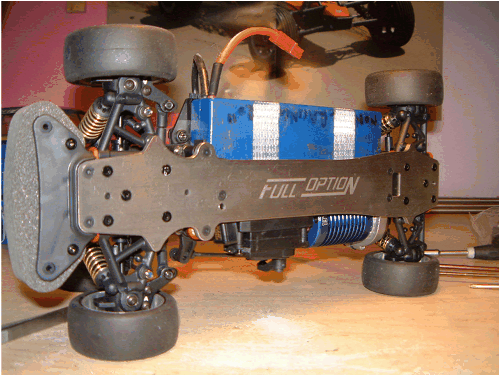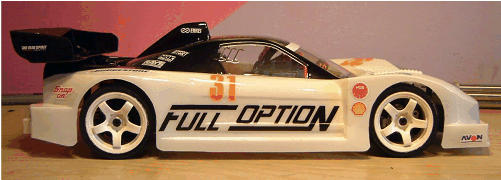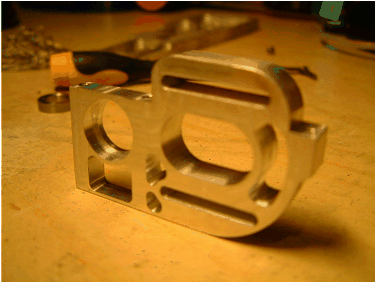I chose the HPI Cup Racer as it embodies everything I like about RC racing. Ultimately it is a pretty accurate scale model of whatever body you are running. The chassis is changed to suit the body, which is the way I have always approached touring cars. It has a massive range of wheelbase and track adjustments to achieve this. Not to mention, 2 styles of front suspension options and a whole pile of different configurations of body mounts, out of the box.
My goal with the Cup Racer was to make it a competitive car in our club's touring car A class. Could this scale car be made as fast as a pro-spec tourer?
Tyres
As with most racing classes the tyre choice dominates the performance of the car. I still don't think I have found the sweet spot here. Certainly for almost any surface I doubt the kit tyres will be much good. They are quite high profile slicks, not that grippy and come with wheels that are a strange size and only fit the kit tyres. Put a touring car wheel on here and the car looks goofy. You kill the scale appearance immediately and raise the ride height too, if you then lower it the suspension geometry is badly compromised. I am using Tamiya M-chassis wheels which are only a tiny bit smaller than stock. I machine the grooves off them and slide on foams. Current best on carpet here are Jap 38 shores from Kamtec. I've tried Mardave Pink Mediums (fast wear) and Gecko 35s (way too soft and too inconsistent between packs). I use CS High Grip additive on the rears and occasionally on the front too. On the kit tyres there is absolutely no way this car will get anywhere near a touring car. I have yet to try and Tamiya M-chassis rubbers but they are unlikely to deliver the performance of foams, on our tight carpet track.
Transmission
This is where most of my work has gone. The car isn't designed for high power, maximum performance racing so I hold nothing against HPI here. If you want your Cup Racer to challenge for A-final wins you'll need to show the highest commitment, that's both on the track and in the machine shop. Some people have looked on and commented that I might be polishing a turd here, which is unfair to the original design intent. Not to worry though, because this turd is in fact buffing up to a pretty good shine.
1. The drive stub axles that engage the wheels are plastic. The dogs that transmit the torque are weak and will shear under high loads. The lightest of barrier clips with a fast motor can take one of these out. I remade mine out of Ti 6Al4V for a bomb proof solution.
2. The drive cup to the front diff is easy to break in the same way. I made a steel one.
3. The ball diff that comes in the rear can not handle high torque loading. There's no getting away from this one. With no aftermarket support (yet) I remade the entire diff in 303 stainless steel, CNC machined a delrin ball cage to support a full compliment of silicon nitride ceramic balls. This was a ton of work on a very high precision assembly but I now have the security of knowing my diff isn't going to melt down, like the stock one did.
4. The car is designed to run on fairly high turn, low output motors. The manual suggests a 30 turn. Not going to cut it on the race track against fire breathing opposion. I currently run an 11.5T brushless on a Hobbywing Extreme Stock boosted ESC. With the timing turned up these generate an incredible amount of power. The problem is, the car's gearing can't be adjusted low enough to run the high RPM the motor generates. This was fixed with a CNC machined aluminium motor mount and transmission plate. 27-65 is the lowest gearing you can run as standard, while my car could now go all the way to 19-67. The added bonus is the motor is now mounted much lower on the chassis and a lot closer to the centreline, improving handling.
Chassis
To eliminate twisting under high motor loads and to reduce the car's high CG, I machined a custom chassis from steel plate. This adds a lot of weight, but it is a worthwhile compromise as it is in the lowest possible location. When cornering hard, the Cup Racer is more likely to roll than 190mm cars as is is somewhat narrower. This mod significantly reduces this tendency.
I also removed all of the preload spacers from the rear shocks and remade the shock tower in 3mm carbon. This has no effect on the suspension other than lowering the top mounting points by over 7mm which is good for handling and is also required for the Kawada NSX body I used.
Body
The world is your oyster here. I've used a few so far:
Tamiya Fiat 500 Abarth Assetto Corse
HPI BMW 2002
Kawada NSX GT
Ride EVO-X
But any M-size body will fit. That's one of the best things about the Cup Racer.
Performance
So far I am competitive but only if I make a clean run, the car is skittish and hard to drive compared with a touring car. It's right on the limit of the power you can put through the small chassis but I am only a couple of tenths off the fastest lap most weeks. I need to get the suspension stiffer and I could make up that time. Compared with the car when I got it though, it is many seconds faster per lap. I wouldn't recommend anyone tries this unless you are a builder as you will end up constantly fixing a broken car which ultimately would be best racing in a class of 4WD minis of a similar spec.






